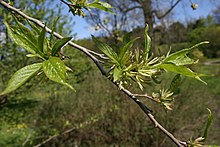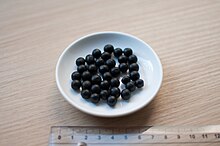Eucommia ulmoides
| Eucommia ulmoides | |
|---|---|

| |
| Foliage and flowers | |
| Scientific classification | |
| Kingdom: | Plantae |
| Clade: | Tracheophytes |
| Clade: | Angiosperms |
| Clade: | Eudicots |
| Clade: | Asterids |
| Order: | Garryales |
| Family: | Eucommiaceae |
| Genus: | Eucommia |
| Species: | E. ulmoides
|
| Binomial name | |
| Eucommia ulmoides | |
Eucommia ulmoides is a species of small
Description
Eucommia ulmoides grows to about 15 m tall. The leaves are
Taxonomy
E. ulmoides is the sole living species of the genus
Distribution
This tree is also occasionally planted in botanical gardens and other gardens in Europe, North America and elsewhere, being of interest as the only cold-tolerant (to at least -30 °C) rubber-producing tree. Fossils of other Eucommia species have been found in 10- to 35-million-year-old brown coal deposits in central Europe and widely in North America, indicating that the genus had a much wider range in the past.[3]
Uses

It is one of the 50 fundamental herbs used in Chinese herbology, where it is called dùzhòng (Chinese: 杜仲). Because of the low production and high demand for natural rubber in China, a unique process has been developed to manufacture elastic materials with Eucommia ulmoides gum (EUG) as substitutes for natural rubber products. Unlike the latex used to produce natural rubber, the EUG is the polymer trans-1,4-polyisoprene. Thus materials made from EUG may demonstrate characteristics other than those of natural rubber, such as higher elasticity, lower thermoplastic temperature, etc.
Chemistry
The iridoid glucoside geniposidic acid can be found in E. ulmoides.
See also
- Chinese herbology 50 fundamental herbs
References
- . Retrieved 19 November 2021.
- ^ "IPNI Plant name details Eucommia ulmoides". Archived from the original on 4 March 2016. Retrieved 9 September 2013.
- S2CID 20464075.
- HUEC Nutrition & Obesity (including Eucommia bark results) online (ppt)

